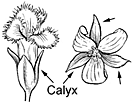Candlenut
Aleurites moluccanus
Spurge family (Euphorbiaceae)
Polynesian introduction
Kukui, the State tree of Hawaii, is well known and is recognized from a distance by its silvery green or grayish foliage. This large spreading tree is common in moist lowland mountain forests through the Hawaiian Islands. The large long-stalked leaves are mostly three- or five- and have five or seven main veins from base. This species was apparently introduced by the early Hawaiians for the large nutlike elliptical, hard, oily seeds, for which many uses have been found.

©2002 Forest And Kim Starr
Leaves with stout leaf-stalks of 3–6 inches (7.5–15 ) or more, often longer than blades, yellow green hairy, with two dot at top above. Blades mostly 4–8 inches (10–20 ) long and wide, broadly with three or five (sometimes seven) long-pointed or none, base nearly straight, thin, upper surface green and becoming hairless, lower surface light green with star-shaped hairs along veins.
Flower clusters ( ) much forked, hairy, 3 1⁄2–6 inches (9–15 ) long and broad, bearing many white flowers about 3⁄8 inch (10 ) long, mostly male and few female toward base (). Male flowers are many, consisting of rounded hairy 1⁄8 inch (3 ) long, splitting into two or three a of five white petals 5⁄16 inch (8 ) long, and 15–20 Female flowers are few, composed of and with hairy round two-celled two-ovuled and two each two-forked.
Stone are rounded, greenish to brown, 1 1⁄2–2 inches (4–5 ) in diameter, borne singly on stout stalks, leathery and slightly fleshy, not splitting open. Seeds 1–2, elliptical, about 1 inch (2.5 ) long, with a hard, rough black shell.
The wood is white, lightweight ( gr. 0.35), soft, and of fine to coarse texture, the fine-textured type having the appearance of holly (Ilex) wood. It is usually colored by blue stain fungi before conversion to lumber and is not resistant to decay or insects. The wood is not currently utilized but was used by the Hawaiians for lightweight canoes and fishnet floats.
Because of its low durability, kukui is an excellent host for the edible bracket fungus pepeiao akua (Auricularia polytricha). During the 1800s, Chinese immigrants developed an industry of growing pepeiao on felled kukui logs for local consumption and shipment to China. A large amount of kukui was destroyed to support this industry.
Kukui was made the official tree of the State of Hawaii because of “the multiplicity of its uses to the ancient Hawaiians for light, fuel, medicine, dye, and ornament, as well as the distinctive beauty of its light green foliage which embellishes many of the slopes of our beloved mountains.” The State Legislature took this action in 1959.
Hawaiians had many uses for the big seeds, which are borne in large quantities—as many as 75–100 pounds (34–45 kg) annually—by a large tree. The seed shells, black when mature and white earlier, were made into leis and now into costume jewelry and curios. After roasting and shelling, the oil seeds were strung on a piece of coconut for torches or candles, as the English name indicates. Oil pressed from the seeds was burned in stone lamps and, mixed with soot, used as paint. It has been extracted commercially for use as a drying oil in paints and varnishes, and for medicines. Long ago, as many as 10,000 gallons (37,879 liters) of oil were exported annually, but the high cost of labor, even in early times, made the industry unprofitable. The oil cake served as fertilizer and as cattle food. The raw seeds are reported to be toxic or purgative and should be eaten only in moderation. However, roasting or cooking apparently reduces the danger. The Hawaiians ate the roasted kernels with seaweed (limu) and salt as a condiment called ‘inamona, which tastes somewhat like peanuts.
The whitish sap or latex, like a gum or resin, served as a folk remedy and was painted on tapa or bark cloth to make it more durable and waterproof. The Hawaiians obtained from the green covering a black dye for tattooing and from root bark another for painting canoes. An infusion of bark and water was a fish net preservative. Additional uses were recorded by Degener (1930, p. 193–199).
Kukui is common as a wild tree in moist lowland forests from sea level to 2200 ft (671 ) altitude through the Hawaiian Islands. Also planted as a shade and ornamental tree. Kukui, along with koa, was one of the first trees planted widely by the Division of Forestry as watershed cover. The extensive stands in the gullies of the Honolulu Watershed Forest Reserve resulted from those plantings begun in 1904. The Division of Forestry records the planting of 16,000 kukui through the islands.
Special areas
Keahua, Waimea Arboretum, Foster, Tantalus, Haleakala, City, Volcanoes
Champion
Height 67 ft (20.4 ), c.b.h. 10.6 ft (3.2 ), spread 59 ft (18 ). Kapapala, Pahala, Hawaii (1968).
Range
Native probably of Malaysian region and named for the Moluccan Islands, the exact home uncertain. Widely spread by the early inhabitants through the Pacific Islands to Hawaii. Introduced elsewhere through the tropics and becoming naturalized. Uncommon in Puerto Rico and the Virgin Islands.
Other common names
tutui, candlenut; nuez, nuez de India (Puerto Rico); lumbang (Guam); Sakan (Palau); lama (Am. Samoa)









